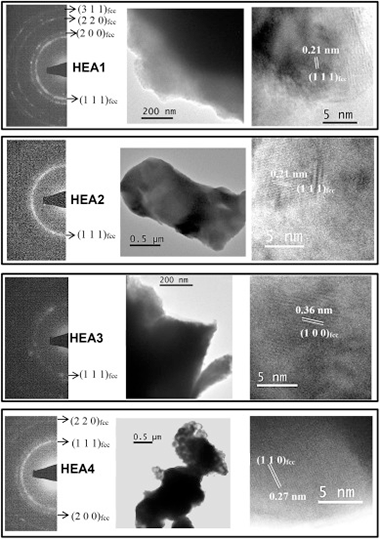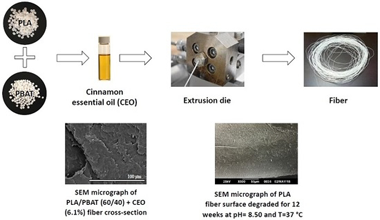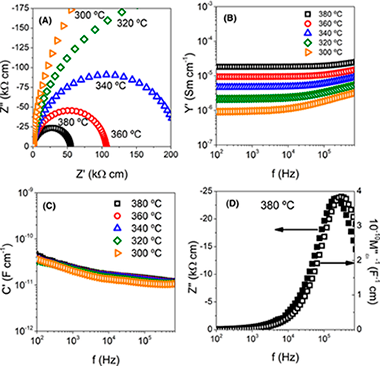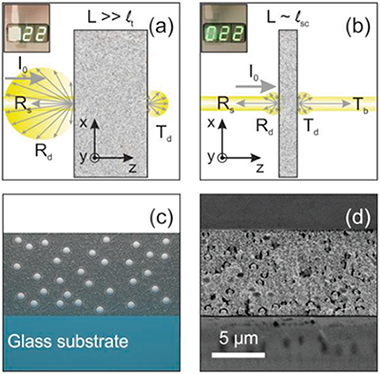Artículos SCI
2020
2020
Reactividad de Sólidos
Development of Ti(C,N)-based cermets with (Co,Fe,Ni)-based high entropy alloys as binder phase
de la Obra, AG; Sayagues, MJ; Chicardi, E; Gotor, FJJournal of Alloys and Compounds, 814 (2020) 152218
Show abstract ▽

High entropy alloys have been proposed as novel binder phases in cemented carbides and cermets. Many aspects related to the stability of these alloys during the liquid phase sintering process are still unclear and were addressed in this work. Consolidated Ti(C,N)-based cermets using four different (Co,Fe,Ni)based high entropy alloys as the binder phase were obtained. The chosen alloys - CoCrCuFeNi, CoCrFeNiV, CoCrFeMnNi and CoFeMnNiV - were previously synthesized through mechanical alloying and a single alloyed solid solution phase with fcc structure and nanometric character was always obtained. The powdered alloys and the consolidated cermets were analyzed by X-ray diffraction, scanning electron microscopy, X-ray energy dispersive spectrometry and transmission electron microscopy. Differential thermal analysis was employed to determine the melting point of the four high entropy alloys that ranged between 1310 degrees C and 1375 degrees C. Although a high temperature of 1575 degrees C was required to obtain the highest cermet densification by pressureless sintering, porosity still remained in most of the cermets. Best densification was achieved when CoCrFeNiV was used as the binder phase. During liquid phase sintering, different compositional changes were observed in the ceramic and binder phases. A core-rim microstructure was observed in cermets containing V in the alloys (CoCrFeNiV and CoFeMnNiV), since this element was incorporated to the carbonitride structure during sintering. A slight Cr segregation was detected in cermets containing Cr, leading to CrTi-rich alloys in small binder regions. However, a great Cu segregation was produced when CoCrCuFeNi was used, and the formation of two different fcc alloys -a Cu-rich and a Cu-depleted- was observed. Finally, a loss of Mn was also evidenced in CoCrFeMnNi and CoFeMnNiV, probably due to its sublimation at the sintering temperature.
Enero, 2020 | DOI: 10.1016/j.jallcom.2019.152218
Materiales de Diseño para la Energía y Medioambiente
Preparation and Characterization of Bio-Based PLA/PBAT and Cinnamon Essential Oil Polymer Fibers and Life-Cycle Assessment from Hydrolytic Degradation
Correa-Pacheco, ZN; Black-Solis, JD; Ortega-Gudino, P; Sabino-Gutierrez, MA; Benitez-Jimenez, JJ; Barajas-Cervantes, A; Bautista-Banos, S; Hurtado-Colmenares, LBPolymers, 12 (2020) 38
Show abstract ▽

Nowadays, the need to reduce the dependence on fuel products and to achieve a sustainable development is of special importance due to environmental concerns. Therefore, new alternatives must be sought. In this work, extruded fibers from poly (lactic acid) (PLA) and poly (butylene adipate-co-terephthalate) (PBAT) added with cinnamon essential oil (CEO) were prepared and characterized, and the hydrolytic degradation was assessed. A two-phase system was observed with spherical particles of PBAT embedded in the PLA matrix. The thermal analysis showed partial miscibility between PLA and PBAT. Mechanically, Young's modulus decreased and the elongation at break increased with the incorporation of PBAT and CEO into the blends. The variation in weight loss for the fibers was below 5% during the period of hydrolytic degradation studied with the most important changes at 37 degrees C and pH 8.50. From microscopy, the formation of cracks in the fiber surface was evidenced, especially for PLA fibers in alkaline medium at 37 degrees C. This study shows the importance of the variables that influence the performance of polyester-cinnamon essential oil-based fibers in agro-industrial applications for horticultural product preservation.
Enero, 2020 | DOI: 10.3390/polym12010038
Reactividad de Sólidos
Processing and properties of Bi0.98R0.02FeO3 (R = La, Sm, Y) ceramics flash sintered at similar to 650 degrees C in <5 s
Gil-Gonzalez, E; Perejon, A; Sanchez-Jimenez, PE; Raj, R; Perez-Maqueda, LAJournal of the American Ceramic Society, 103 (2020) 136-144
Show abstract ▽

We show that flash sintering produces single‐phase, nanograin‐sized polycrystals of isovalent‐substituted multiferroic ceramics of complex compositions. Single‐phase polycrystals of Bi0.98R0.02FeO3 (R = La, Sm, Y) were produced at a furnace temperature of ~650°C in a few seconds by the application of an electric field of 50 V cm−1, with the current limit set to 40 mA mm−2. The dielectric and insulating properties compared favorably with expected values. Impedance spectroscopy suggests electrically homogenous microstructure, except for the sample Bi0.98La0.02FeO3 that shows a small grain boundary contribution to the impedance. These results reinforce the enabling nature of flash sintering for ceramics which pose difficulties in conventional sintering because they contain low melting constituents or develop secondary phases during the sintering protocol.
Enero, 2020 | DOI: 10.1111/jace.16718
Materiales Ópticos Multifuncionales
Finite Size Effects on Light Propagation throughout Random Media: Relation between Optical Properties and Scattering Event Statistics
Miranda-Munoz, JM; Esteso, V; Jimenez-Solano, A; Lozano, G; Miguez, HAdvanced Optical Materials, 8 (2020) 1901196
Show abstract ▽

This work introduces a thorough analysis of light transport in thin optically disordered media. The diffusive properties of a turbid material are generally dictated by the transport mean free path, lt. For depths larger than this characteristic length, light propagation can be considered fully randomized. There is however a range of thicknesses for which light becomes only partly randomized, as it only undergoes a single or very few scattering events. The effects of such finitude are experimentally and theoretically studied on the optical properties of the material, such as the angular distribution of scattered light. Simulations provide insight into the phenomena that occur within the optically disordered slab, like the number of scattering events that photons undergo during propagation throughout the material, as a function of the built‐in wavelength dependent scattering mean free path, lsc. This approach provides fundamental information about photon transport in finite optically random media, which can be put into practice to design diffusers with specific requirements in terms of the spectral and angular properties of the scattered light.
Enero, 2020 | DOI: 10.1002/adom.201901196
Materiales Avanzados
New waste-based clinkers for the preparation of low-energy cements. A step forward toward circular economy
Martinez-Martinez, S; Perez-Villarejo, L; Eliche-Quesada, D; Sanchez-Soto, PJ; Christogerou, A; Kanellopoulou, DG; Angelopoulos, GNInternational Journal of Applied Ceramic Technology, 17 (2020) 12-21
Show abstract ▽
This paper describes the use of industrial wastes arising from different production processes of the ceramic and marble industries as raw materials for the design and formulation of new cement clinkers with a high content of dicalcium silicate (Belite). The aim was to reintroduce these wastes in the industrial sector and take advantage of them for a greater environmental benefit, as indicated by the principles of the circular economy. Formulations containing 2.5, 5 and 10 wt% of chamotte and marble sludge, respectively, and a waste-free formulation have been designed to obtain clinkers with a content of dicalcium silicate higher than 60 wt%. The different blends have been studied up to a maximum temperature of 1390 degrees C by Thermal Analysis. Other techniques such as XRD, XRF, Modified Bogue Equation, Quality Indexes (LSF, AM, SM) and Optical Microscopy have been used for the study and characterization of industrial wastes, the raw materials and the high belite-type cement dosages. The results indicate that this type of cements can be designed using different types of wastes and in this way reduce the environmental impacts caused by the extraction of raw materials and the deposition of the wastes in landfills, improving the circular economy of the construction industry.
Enero, 2020 | DOI: 10.1111/ijac.13390
- ‹ anterior
- 108 of 410
- siguiente ›














